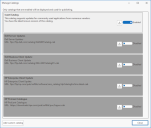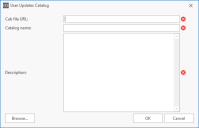Managing Catalogs
You use the Catalogs button to select which update catalogs should be used by the program. You access this button from the Ivanti Patch > Updates workspace.
The Ivanti catalog, which is the primary catalog, will be enabled by default. The SHA-1 hash of the installers were collected by Ivanti when the installers were added to the catalog and are then validated locally when downloaded by Patch for Configuration Manager. Catalogs from other vendors may also be provided by Ivanti and appear in this list. You can also add your own custom catalogs.
To enable an optional catalog, toggle the Disabled button to Enabled. When you enable a catalog, the most current revision of the catalog will be automatically imported. You can import multiple catalogs at the same time. The updates within the catalog will be displayed within the Ivanti Patch > Updates workspace.
Any active catalogs that are provided by Ivanti will be automatically updated when new versions become available. Custom catalogs (those that you provide) are not automatically updated. To retrieve updates for a custom catalog, select it and then click the Get latest icon.
![]() Get latest: Select a catalog and then click this button to force an immediate check for the latest version of the catalog. The catalog will be downloaded from the URL shown in the catalog description. The catalog will be saved to the current user's \Ivanti\Patch directory (for example: C:\Users\Your.Name\Ivanti\Patch). When the import is complete, the phrase You have the latest known revision of this catalog will be displayed within the description. If you don't click this button, don't worry. A check for the latest active catalogs is automatically performed each time you access Configuration Manager.
Get latest: Select a catalog and then click this button to force an immediate check for the latest version of the catalog. The catalog will be downloaded from the URL shown in the catalog description. The catalog will be saved to the current user's \Ivanti\Patch directory (for example: C:\Users\Your.Name\Ivanti\Patch). When the import is complete, the phrase You have the latest known revision of this catalog will be displayed within the description. If you don't click this button, don't worry. A check for the latest active catalogs is automatically performed each time you access Configuration Manager.
![]() Delete imported data: Deletes all data for the selected catalog. If you delete the imported data, you will need to re-import the data before publishing additional updates from this catalog.
Delete imported data: Deletes all data for the selected catalog. If you delete the imported data, you will need to re-import the data before publishing additional updates from this catalog.
You cannot delete data for the Ivanti catalog.
Custom Catalogs
Add custom catalog: Use this button to add a new third-party catalog. In the User Updates Catalog dialog, you must provide a valid URL or URI path to the catalog file (usually a .cab or .zip file) as well as a name and a description for the catalog. Providing a URL is the recommended method, as downloading the catalog first and adding it as a file will prevent the catalog from being automatically updated.
![]() Edit: Enables you to edit the URL, name and description of the selected catalog. You can only edit those custom catalogs that you have added; catalogs defined in the product manifest cannot be edited.
Edit: Enables you to edit the URL, name and description of the selected catalog. You can only edit those custom catalogs that you have added; catalogs defined in the product manifest cannot be edited.
![]() Remove: Removes the selected catalog. You can only remove those custom catalogs that you have added; catalogs provided by Ivanti cannot be removed, but they can be disabled and the data files can be deleted.
Remove: Removes the selected catalog. You can only remove those custom catalogs that you have added; catalogs provided by Ivanti cannot be removed, but they can be disabled and the data files can be deleted.

